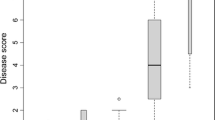Abstract
Key message
Major QTL for Phytophthora root rot resistance have been identified in three mapping populations with independent sources of resistance contributed by C. echinospermum and C. arietinum.
Abstract
Phytophthora root rot (PRR) caused by the oomycete Phytophthora medicaginis is a major soil-borne disease of chickpea in Australia. With no economic in-crop control of PRR, a genetic approach to improve resistance is the most practical management option. Moderate field resistance has been incorporated in the cultivated C. arietinum variety, Yorker, and a higher level of resistance has been identified in a derivative of wild chickpea (C. echinospermum, interspecific breeding line 04067-81-2-1-1). These genotypes and two other released varieties were used to develop one intra-specific and two interspecific F6-derived recombinant inbred line mapping populations for genetic analysis of resistance. The Yorker × Genesis114 (YG), Rupali × 04067-81-2-1-1 (RB) and Yorker × 04067-81-2-1-1 (YB) populations were genotyped using genotyping-by-sequencing and phenotyped for PRR under three field environments with a mixture of 10 P. medicaginis isolates. Whole-genome QTL analysis identified major QTL QRBprrsi01, QYBprrsi01, QRBprrsi03 and QYBprrsi02 for PRR resistance on chromosomes 3 and 6, in RB and YB populations, respectively, with the resistance source derived from the wild Cicer species. QTL QYGprrsi02 and QYGprrsi03 were also identified on chromosomes 5 and 6 in YG population from C. arietinum. Aligning QTL regions to the corresponding chickpea reference genome suggested that the resistance source from C. arietinum and C. echinospermum may be different. The findings from this study provide tools for marker-assisted selection in chickpea breeding and information to assist the development of populations suitable for fine-mapping of resistance loci to determine the molecular basis for PRR resistance in chickpea.



Similar content being viewed by others
References
Barchenger DW, Sheu Z-M, Kumar S, Lin S-W, Burlakoti RR, Bosland PW (2018) Race characterization of Phytophthora root rot on capsicum in Taiwan as a basis for anticipatory resistance breeding. Phytopathology. PHYTO-08-17-0289-R
Berger J, Abbo S, Turner NC (2003) Ecogeography of annual wild cicer species. Crop Sci 43:1076–1090
Berger J, Turner N, Siddique K, Knights E, Brinsmead R, Mock I, Edmondson C, Khan T (2004) Genotype by environment studies across Australia reveal the importance of phenology for chickpea (Cicer arietinum L.) improvement. Crop Pasture Sci 55:1071–1084
Bonneau J, Taylor J, Parent B, Bennett D, Reynolds M, Feuillet C, Langridge P, Mather D (2013) Multi-environment analysis and improved mapping of a yield-related QTL on chromosome 3B of wheat. Theor Appl Genet 126:747–761
Broman KW, Wu H, Sen Ś, Churchill GA (2003) R/qtl: QTL mapping in experimental crosses. Bioinformatics 19:889–890
Butler D, Cullis B, Gilmour A, Gogel B (2009) Reference manual, version 3. Queensland Department of Primary Industries and Fisheries, Brisbane
Croser JS, Ahmad F, Clarke HJ, Siddique KHM (2003) Utilisation of wild Cicer in chickpea improvement- progress, constraints, and prospects. Aust J Agric Res 54:429–444
Croser J, Ribalta F, Navarro MP, Munday C, Bennett R, Kaur P, Ochatt S (2018) In vitro-assisted compression of breeding cycles. Biotechnologies of Crop Improvement, vol 1. Springer, New York, pp 463–486
Cullis BR, Smith AB, Coombes NE (2006) On the design of early generation variety trials with correlated data. J Agric Biol Environ Stat 11:381
Daba K, Deokar A, Banniza S, Warkentin TD, Tar’an B (2016) QTL mapping of early flowering and resistance to ascochyta blight in chickpea. Genome 59:413–425
Dale ML, Irwin J (1991) Glasshouse and field screening of chickpea cultivars for resistance to Phytophthora megasperma f. sp. medicaginis. Anim Prod Sci 31:663–667
Hackett C, Meyer R, Thomas W (2001) Multi-trait QTL mapping in barley using multivariate regression. Genet Res 77:95–106
Hamwieh A, Imtiaz M, Malhotra R (2013) Multi-environment QTL analyses for drought-related traits in a recombinant inbred population of chickpea (Cicer arientinum L.). Theor Appl Genet 126:1025
Jaganathan D, Thudi M, Kale S, Azam S, Roorkiwal M, Gaur PM, Kishor PBK, Nguyen H, Sutton T, Varshney RK (2015) Genotyping-by-sequencing based intra-specific genetic map refines a ‘‘QTL-hotspot” region for drought tolerance in chickpea. Mol Genet Genomics 290:559–571
Jain M, Misra G, Patel RK, Priya P, Jhanwar S, Khan AW, Shah N, Singh VK, Garg R, Jeena G, Yadav M, Kant C, Sharma P, Yadav G, Bhatia S, Tyagi AK, Chattopadhyay D (2013) A draft genome sequence of the pulse crop chickpea (Cicer arietinum L.). Plant J 74:715–729
Jansen RC (1994) Controlling the type I and type II errors in mapping quantitative trait loci. Genetics 138:871–881
Knights EJ, Açıkgöz N, Warkentin T, Bejiga G, Yadav SS, Sandhu JS (2007) Area, production and distribution. In: Yadav SS, Redden RJ, Chen W, Sharma B (eds) Chickpea breeding and management. CABI, Wallingford, pp 167–178
Knights EJ, Southwell RJ, Schwinghamer MW, Harden S (2008) Resistance to Phytophthora medicaginis Hansen and Maxwell in wild Cicer species and its use in breeding root rot resistant chickpea (Cicer arietinum L.). Aust J Agric Res 59:383–387
Kujur A, Upadhyaya HD, Shree T, Bajaj D, Das S, Saxena MS, Badoni S, Kumar V, Tripathi S, Gowda CLL, Sharma S, Singh S, Tyagi AK, Parida SK (2015) Ultra-high density intra-specific genetic linkage maps accelerate identification of functionally relevant molecular tags governing important agronomic traits in chickpea. Sci Rep 5:9468
Li J, Ji L (2005) Adjusting multiple testing in multilocus analyses using the eigenvalues of a correlation matrix. Heredity 95:221–227
Li J, Dai X, Liu T, Zhao PX (2012) LegumeIP: an integrative database for comparative genomics and transcriptomics of model legumes. Nucl Acids Res 40:D1221–D1229
Li H, Rodda M, Gnanasambandam A, Aftab M, Redden R, Hobson K, Rosewarne G, Materne M, Kaur S, Slater AT (2015) Breeding for biotic stress resistance in chickpea: progress and prospects. Euphytica 204:257–288
Li L, Lin F, Wang W, Ping J, Fitzgerald JC, Zhao M, Li S, Sun L, Cai C, Ma J (2016) Fine mapping and candidate gene analysis of two loci conferring resistance to Phytophthora sojae in soybean. Theor Appl Genet 129:2379–2386
Linde BAMaC (2002) Pathogen population genetics, evolutionary potential, and durable resistance. Annu Rev Phytopathol 40:349–379
Malosetti M, Ribaut JM, van Eeuwijk FA (2014) Drought phenotyping in crops: from theory to practice, frontiers E-books. the statistical analysis of multi-environment data: modeling genotype-by-environment interaction and its genetic basis, p 53
Martinez O, Curnow RN (1994) Missing markers when estimating quantitative trait loci using regression mapping. Heredity 73:198–206
Meng L, Li H, Zhang L, Wang J (2015) QTL IciMapping: Integrated software for genetic linkage map construction and quantitative trait locus mapping in biparental populations. Crop J 3:269–283
Murray GM, Brennan JP (2012) The current and potential costs from diseases of pulse crops in Australia: GRDC Research Code: CER00002. Grains Research and Development Corporation, Barton ACT
Nivedita Verma PK, Upadhyaya KC (2017) Lectin protein kinase is induced in plant roots in response to the endophytic fungus, Piriformospora indica. Plant Mol Biol Rep 35:323–332
Poland JA, Balint-Kurti PJ, Wisser RJ, Pratt RC, Nelson RJ (2009) Shades of gray: the world of quantitative disease resistance. Trends Plant Sci 14:21–29
Schwenke GD, Peoples MB, Turner GL, Herridge DF (1998) Does nitrogen fixation of commercial, dryland chickpea and faba bean crops in north-west New South Wales maintain or enhance soil nitrogen? Aust J Exp Agric 38:61–70
Schwinghamer MW, Southwell R, Moore K, Knights E (2011) Phytophthora root rot of chickpea. In: W. Chen HCSaFJM (ed) Compendium of chickpea and lentil diseases and pests. The American Phytopathological Society, St Paul, pp 22–25
Singh K, Ocampo B (1997) Exploitation of wild Cicer species for yield improvement in chickpea. Theor Appl Genet 95:418–423
Singh S, Gumber R, Joshi N, Singh K (2005) Introgression from wild Cicer reticulatum to cultivated chickpea for productivity and disease resistance. Plant Breed 124:477–480
Smith A, Cullis B, Gilmour A (2001) Applications: the analysis of crop variety evaluation data in Australia. Aust New Z J Stat 43:129–145
Smith A, Cullis BR, Thompson R (2005) The analysis of crop cultivar breeding and evaluation trials: an overview of current mixed model approaches. J Agric Sci 143:449–462
Southwell RJ, Crocker GJ (2005) Hedysarum—a new susceptible host for Phytophthora medicaginis. Aust Plant Pathol 34:265–267
Sugimoto T, Kato M, Yoshida S, Matsumoto I, Kobayashi T, Kaga A, Hajika M, Yamamoto R, Watanabe K, Aino M (2012) Pathogenic diversity of Phytophthora sojae and breeding strategies to develop Phytophthora-resistant soybeans. Breed Sci 61:511–522
Taylor J, Butler D (2017) R Package ASMap: efficient genetic linkage map construction and diagnosis. J Stat Softw 79:1–29
Taylor J, Verbyla A (2011) R Package wgaim: QTL analysis in bi-parental populations using linear mixed models. J Stat Softw 2011(40):18
Team RC (2017) R: A Language and Environment for Statistical Computing. R Foundation for Statistical Computing, Vienna
Thudi M, Bohra A, Nayak SN, Varghese N, Shah TM, Penmetsa RV, Thirunavukkarasu N, Gudipati S, Gaur PM, Kulwal PL (2011) Novel SSR markers from BAC-end sequences, DArT arrays and a comprehensive genetic map with 1291 marker loci for chickpea (Cicer arietinum L.). PLoS One 6:e27275
Tinker N, Mather D (1995) Methods for QTL analysis with progeny replicated in multiple environments. J Agric Genom 1
Varshney RK, Song C, Saxena RK, Azam S, Yu S, Sharpe AG, Cannon S, Baek J, Rosen BD, Tar’an B (2013) Draft genome sequence of chickpea (Cicer arietinum) provides a resource for trait improvement. Nat Biotechnol 31:240–246
Varshney RK, Thudi M, Nayak SN, Gaur PM, Kashiwagi J, Krishnamurthy L, Jaganathan D, Koppolu J, Bohra A, Tripathi S, Rathore A, Jukanti AK, Jayalakshmi V, Vemula A, Singh SJ, Yasin M, Sheshshayee MS, Viswanatha KP (2014) Genetic dissection of drought tolerance in chickpea (Cicer arietinum L.). Theor Appl Genet 127:445–462
Verbyla A, Eckermann P, Thompson R, Cullis B (2003) The analysis of quantitative trait loci in multi-environment trials using a multiplicative mixed model. Crop Pasture Sci 54:1395–1408
Verbyla AP, Cullis BR, Thompson R (2007) The analysis of QTL by simultaneous use of the full linkage map. Theor Appl Genet 116:95
Verbyla AP, Taylor JD, Verbyla KL (2012) RWGAIM: an efficient high-dimensional random whole genome average (QTL) interval mapping approach. Genet Res 94:291–306
Verma S, Gupta S, Bandhiwal N, Kumar T, Bharadwaj C, Bhatia S (2015) High-density linkage map construction and mapping of seed trait QTLs in chickpea (Cicer arietinum L.) using Genotyping-by-Sequencing (GBS). Sci Rep 5:17512
Vock N, Langdon P, Pegg K (1980) Root rot of chickpea caused by Phytophthora megasperma var. sojae in Queensland. Aust Plant Pathol 9:117–117
von Wettberg EJ, Chang PL, Başdemir F, Carrasquila-Garcia N, Korbu LB, Moenga SM, Bedada G, Greenlon A, Moriuchi KS, Singh V (2018) Ecology and genomics of an important crop wild relative as a prelude to agricultural innovation. Nat Commun 9:649
Wagner TA, Kohorn BD (2001) Wall-associated kinases are expressed throughout plant development and are required for cell expansion. Plant Cell 13:303
Wang S, Basten C, Zeng Z (2012) Windows QTL Cartographer 2.5. Department of Statistics, North Carolina State University, Raleigh, NC. Available at: http://statgen.ncsu.edu/qtlcart/WQTL-Cart htm. Last accessed on 23 July 2014
Wu Y, Bhat PR, Close TJ, Lonardi S (2008) Efficient and accurate construction of genetic linkage maps from the minimum spanning tree of a graph. PLoS Genet 4:e1000212
Yadav SS, Chen W (2007) Chickpea Breeding and Management. CABI
Zeng Z-B (1994) Precision mapping of quantitative trait loci. Genetics 136:1457–1468
Acknowledgements
This work was supported by Grains Research and Development Corporation through the project DAN00172 and development of the RIL populations in the project DAN00065 and DAN00094. The PhD candidate A. Amalraj was supported by scholarship from the University of Adelaide and Australian Centre for Plant Functional Genomics. Ted Knights (EJ) instigated the development of the RIL populations. Steve Harden, biometrician, NSW DPI, generated designs for field experiments.
Author information
Authors and Affiliations
Corresponding author
Ethics declarations
Conflict of interest
The authors declare that they have no conflict of interest.
Additional information
Communicated by David A Lightfoot.
Electronic supplementary material
Below is the link to the electronic supplementary material.
Rights and permissions
About this article
Cite this article
Amalraj, A., Taylor, J., Bithell, S. et al. Mapping resistance to Phytophthora root rot identifies independent loci from cultivated (Cicer arietinum L.) and wild (Cicer echinospermum P.H. Davis) chickpea. Theor Appl Genet 132, 1017–1033 (2019). https://doi.org/10.1007/s00122-018-3256-6
Received:
Accepted:
Published:
Issue Date:
DOI: https://doi.org/10.1007/s00122-018-3256-6




